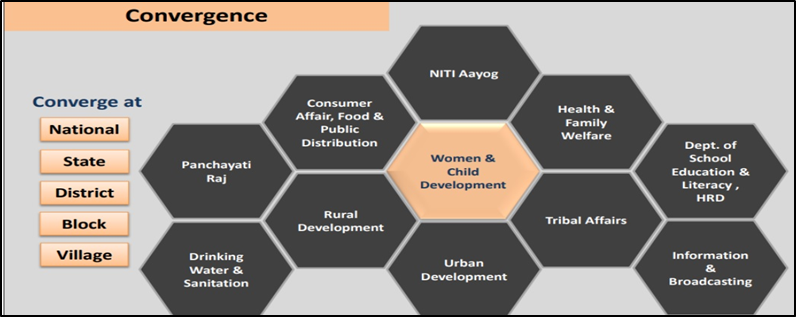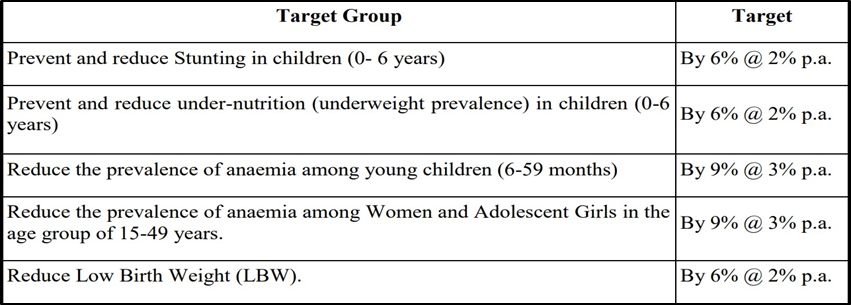In News:
- The Centre has asked states to connect the beneficiaries through its digital malnutrition measuring tool, Poshan tracker, to universalise nutrition access.
What’s in Today’s Article:
- POSHAN Abhiyan – About, goals and target groups, objectives, pillars, ministries involved
- Mission POSHAN 2.0 – About, features
- POSHAN Tracker
- News Summary
In Focus: POSHAN Abhiyan
- Launched in 2018, the focus of Abhiyaan is to lay emphasis on nutritional status of adolescent girls, pregnant women, lactating mothers and children from 0-6 years age.
- It strives to reduce the level of stunning, under-nutrition, Anaemia and low birth weight in children.
Goals and target groups:
- Target of the Abhiyaan is to reduce stunting in children (0-6 years of age) from 38.4% to 25% by 2022.
Objectives
- The objective of POSHAN Abhiyaan is to reduce stunting across districts with the highest malnutrition burden by improving utilization of key anganwadi services and improving the quality of anganwadi services delivery.
- In addition, the POSHAN Abhiyaan explicitly recognizes the need for convergence and coordination such that the benefits of multiple government schemes and programs reach women and children in the first 1000 days of a child’s life.
Pillars of POSHAN Abhiyaan
- ICDS-CAS (Common Application Software); Convergence; Behavioural change, IEC Advocacy;
- Training and Capacity building; Innovations; Incentives; Grievance Redressal.
Ministries involved

Mission POSHAN 2.0
About
- Launched in February 2022, it is an Integrated Nutrition Support Programme.
- It seeks to address the challenges of malnutrition in children, adolescent girls, pregnant women and lactating mothers.
- It aims to optimize the quality and delivery of food under the Supplementary Nutrition Program.
Features
- Poshan 2.0 shall focus on Maternal Nutrition, Infant and Young Child Feeding Norms, Treatment of MAM/SAM (Moderate/ Severe Acute Malnutrition) and Wellness through AYUSH.
- It will rest on the pillars of Convergence, Governance, and Capacity-building.
- Poshan Abhiyan will be the key pillar for Outreach and will cover innovations related to nutritional support, ICT interventions, Media Advocacy and Research, Community Outreach and Jan Andolan.
Poshan Tracker
- Digital infrastructure under the “Poshan Tracker” was rolled out by MoWCD on 1st March 2021 through National e-Governance Division as a governance tool.
- It records real-time data on malnourished and ‘severe acute malnourished’ children in each anganwadi.
- It will strengthen and bring about transparency in nutrition delivery support systems.
- Technology under Poshan Tracker is being leveraged for
- dynamic identification of stunting, wasting, under-weight prevalence among children;
- last mile tracking of nutrition service delivery.
News Summary
- The Centre has instructed state governments and their Women and Child Development (WCD) departments to ensure digitisation of anganwadi services.
- This is to ensure that migrating families can continue accessing the government’s Take Home Ration scheme even if they move to other states.
Key Highlights:
- Focus on migrant families
- Migrating families often fall through the cracks and stop receiving benefits of anganwadi services when they relocate from one state to another, or even between blocks and districts within a state.
- Digitisation of the process
- The govt. is now pushing for complete digitisation of the process so that registration of beneficiaries of one state can be accessed in any other.
- The WCD ministry has proposed that the Anganwadi services should be digitised through the Poshan tracker.
- Even if a family moves, women, and especially children, can continue to get supplementary nutrition given by the government to curb malnutrition.
- The govt. is now pushing for complete digitisation of the process so that registration of beneficiaries of one state can be accessed in any other.
- Will help in battling alarming levels of malnutrition
- According to the NFHS-5, 35.5 percent of children below five years were stunted and 32.1 percent were underweight in 2019-21.
- By connecting the beneficiaries through its digital malnutrition measuring tool, Poshan tracker, the govt is planning to address the issue of malnutrition.
Take Home Ration
- As part of the Centre’s flagship Integrated Child Development Services (ICDS), Take Home Ration (THR) is provided to
- children between 6 months and 3 years,
- pregnant women and lactating mothers, as well as adolescent girls.
- Freshly cooked hot food and a morning snack is provided to children between 3 and 6 years, who attend anganwadi centres daily, for 300 days annually.
